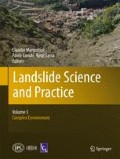Abstract
The modelling of the tsunami generated by the 1888 landslide close to the Trondheim harbour, Norway is revised. Results for the tsunami generation, propagation, and inundation are shown. Improvements for the modelling are made for the generation phase. A special filter for the sea-surface response from the landslide is applied. In this manner the generated waves are more realistic, and spurious trailing waves due to too sharp gradients on the surface are effectively damped. Further, the landslide in the numerical model follows the most likely track for the 1888 event, and not only a straight line as in previous studies.
Access this chapter
Tax calculation will be finalised at checkout
Purchases are for personal use only
References
Bjerrum L (1971) Subaqueous slope failures in Norwegian fjords. Norwegian Geotechnical Institute, Publ. No. 88
ComMIT (2011) Software and documentation, http://nctr.pmel.noaa.gov/ComMIT/index.html, 2011-05-27
Dan G, Sultan N, Savoye B (2007) The 1979 nice harbour catastrophe revisited: trigger mechanism inferred from geotechnical measurements and numerical modelling. Mar Geol 245:40–64
Harbitz CB (1992) Model simulations of tsunamis generated by the storegga slide. Mar Geol 105:1–21
Imran J, Harff P, Parker G (2001) A numerical model of submarine debris flow with graphical user interface. Comput Geosci 27:717–729
Kajiura A (1963) The leading wave of a tsunami. Bull Earthq Res Inst 41:535–571
L’Heureux J-S, Longva O, Hansen L, Vingerhagen G (2007) The 1990 submarine slide outside the Nidelva River mouth, Trondheim, Norway. In: Lykousis V, Sakellariou D, Locat J (eds) Submarine mass movements and their consequences. Kluwer Series on Advances in Natural and Technological Hazards Research 27:259–267
L’Heureux JS, Longva O, Glimsdal S, Hansen L, Harbitz CB, Gauer P (2009) Causes for the 1888 shoreline landslide and tsunami in Trondheimsfjorden, Mid-Norway. In: Proceedings of the 1st international conference on seafloor mapping for geohazard assessment, Ischia Island, 11–13 May 2009
L’Heureux JS, Glimsdal S, Longva O, Hansen L, Harbitz CB (2010) The 1888 shoreline landslide and tsunami in Trondheimsfjorden, central Norway. Special Issue of Marine Geophysical Researches on Seafloor Mapping for Geohazard Assessment. DOI 10.1007/s11001-010-9103-z
L’Heureux JS, Hansen L, Longva O, Emdal A, Grande L (2010b) A multidisciplinary study of submarine landslides at the Nidelva fjord delta, central Norway – Implications for geohazards assessments. Norw J Geol 90:1–20
L’Heureux JS, Hansen L, Longva O, Eilertsen RS (this volume) Landslide along Norwegian fjords: characteristics, triggers and hazard assessment. In: Proceedings of the second world landslide forum, Rome
Locat J, Lee HJ (2002) Submarine landslides: advances and challenges. Can Geotech J 39:193–212
Løvholt F, Harbitz CB, Haugen KB (2005) A parametric study of tsunamis generated by submarine slides in the Ormen Lange/Storegga area off western Norway. Mar Pet Geol 22:219–231
Løvholt F, Pedersen G, Gisler G (2008) Oceanic propagation of a potential tsunami from the La Palma Island. J Geophys Res 113:C09026. doi:10.1029/2007JC004603
Løvholt F, Pedersen G, Glimsdal S (2010) Coupling of dispersive tsunami propagation and shallow water coastal response. In: Accepted for publication in Zahibo N, Pelinovsky E, Yalciner A, Titov V (eds) Proceedings of the “Caribbean Waves 2008” workshop in Guadeloupe Dec 2008. The Open Oceanography Journal 4:71–82
Marr JG, Elverhøi A, Harbitz CB, Imran J, Harff P (2002) Numerical simulation of mud-rich subaqueous debris flows on the glacially active margins of the Svalbard-Barents sea. Mar Geol 188:351–364
Mei CC (1989) The applied dynamics of ocean surface waves: advanced series on ocean engineering. World Scientific, Singapore, 760 p
Pedersen G (2001) A note on tsunami generation by earthquakes. Mech Appl Math 4:1–8
Pedersen G, Løvholt F (2008) Documentation of a global Boussinesq solver. Department of Mathematics, University of Oslo, Norway. http://urn.nb.no/URN:NBN:no-27775
Prior DB, Coleman JM, Bornhold BD (1982) Results of a known instability event. Geo-Mar Lett 2:117–122
Skaven-Haug S (1955) Undervannsskred i Trondheim havneomraade. Teknisk Ukeblad vol 102(7) (also in publ. 7, Norwegian Geotechnical Institute, Oslo, p 133–144)
Tappin DR (2009) Mass transport events and their tsunami hazard. In: Mosher DC, Shipp RC, Moscardelli L, Chaytor JD, Baxter CDP, Lee HL, Urgeles R (eds) Submarine mass movements and their consequences, advances in natural and technological hazards research, vol 28. Springer, Dordrecht, pp 667–684
Acknowledgements
The authors are indebted to the International Centre for Geohazards (ICG) and the Norwegian Geotechnical Institute (NGI) for financing the writing of the present paper. The paper is ICG publication no. 366. Finn Løvholt is acknowledged for his contribution to this paper.
Author information
Authors and Affiliations
Corresponding author
Editor information
Editors and Affiliations
Rights and permissions
Copyright information
© 2013 Springer-Verlag Berlin Heidelberg
About this chapter
Cite this chapter
Glimsdal, S., L’Heureux, JS., Harbitz, C.B., Pedersen, G.K. (2013). Modelling of the 1888 Landslide Tsunami, Trondheim, Norway. In: Margottini, C., Canuti, P., Sassa, K. (eds) Landslide Science and Practice. Springer, Berlin, Heidelberg. https://doi.org/10.1007/978-3-642-31427-8_9
Download citation
DOI: https://doi.org/10.1007/978-3-642-31427-8_9
Published:
Publisher Name: Springer, Berlin, Heidelberg
Print ISBN: 978-3-642-31426-1
Online ISBN: 978-3-642-31427-8
eBook Packages: Earth and Environmental ScienceEarth and Environmental Science (R0)

